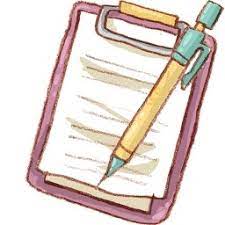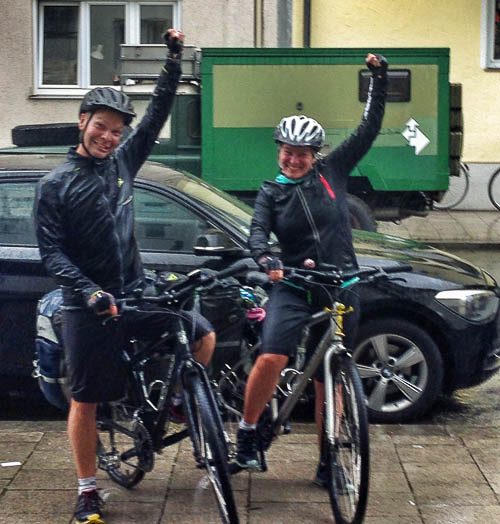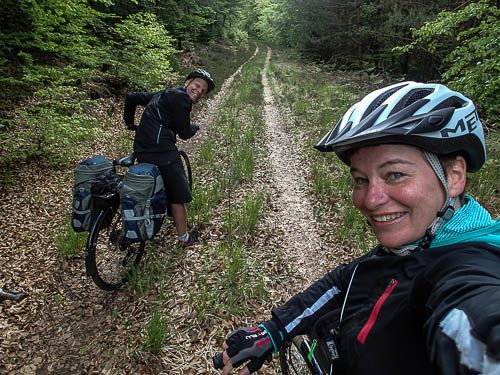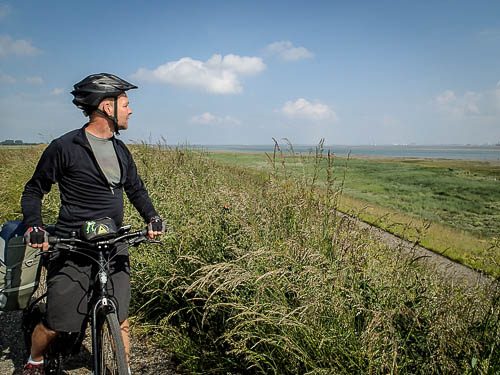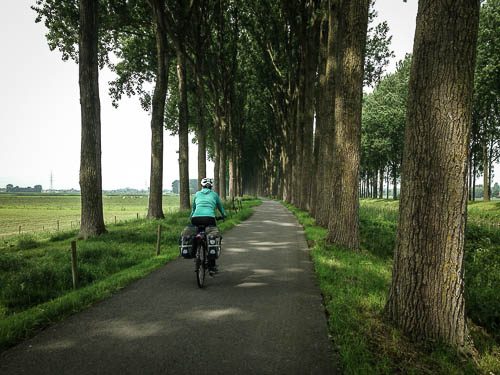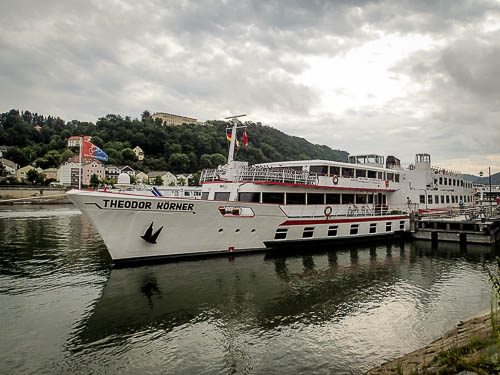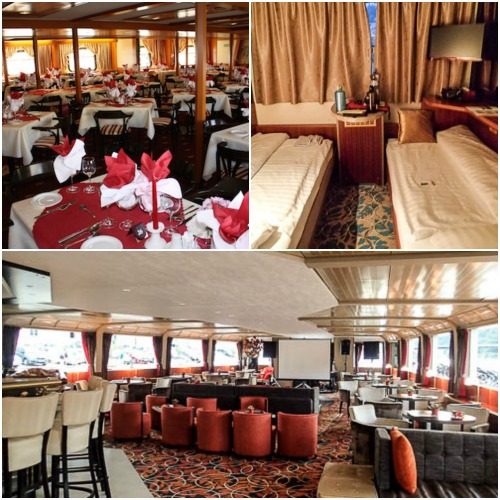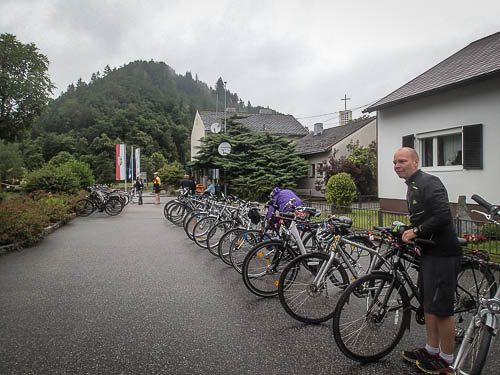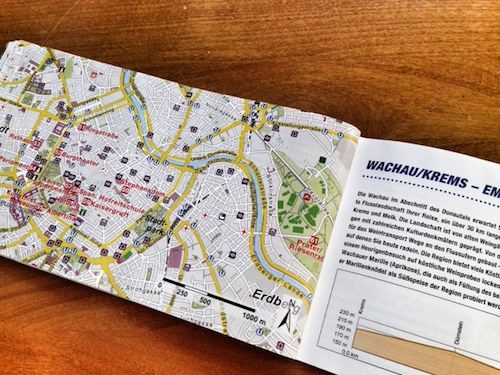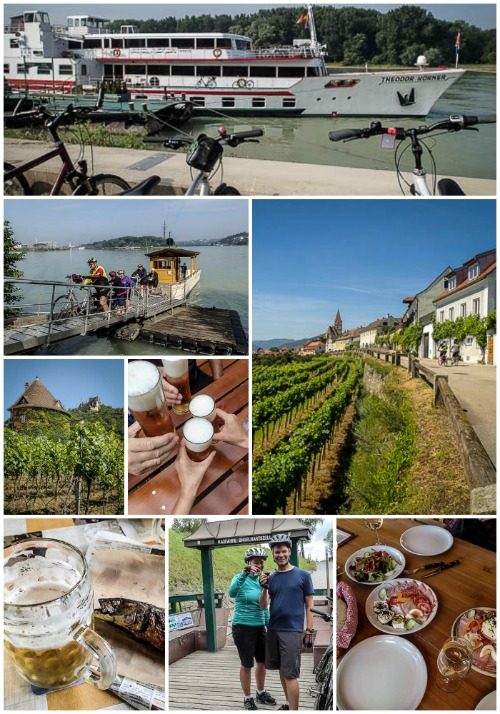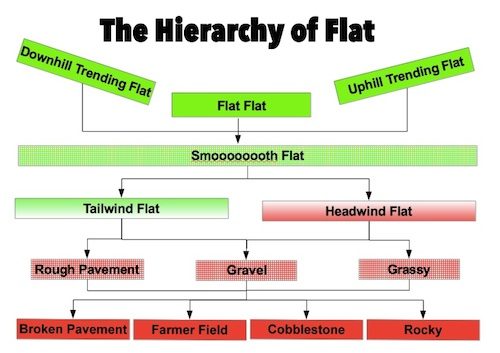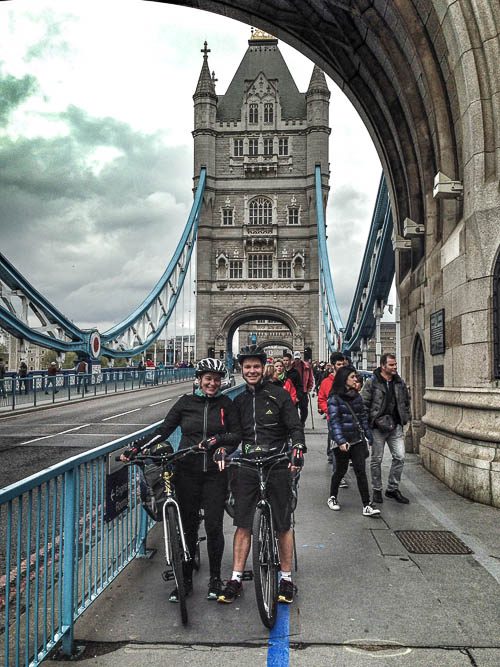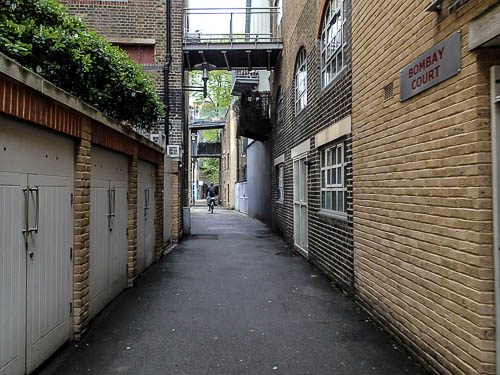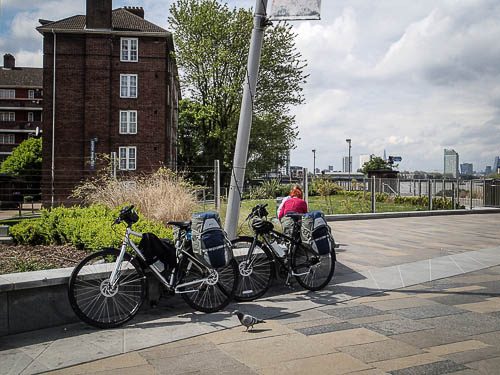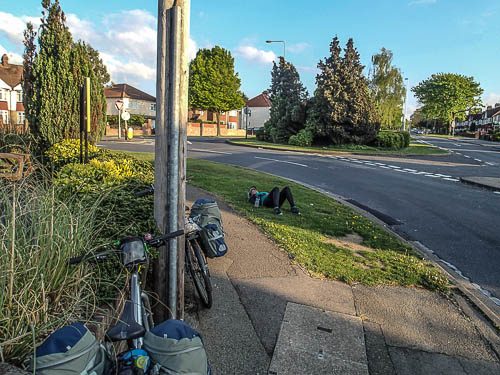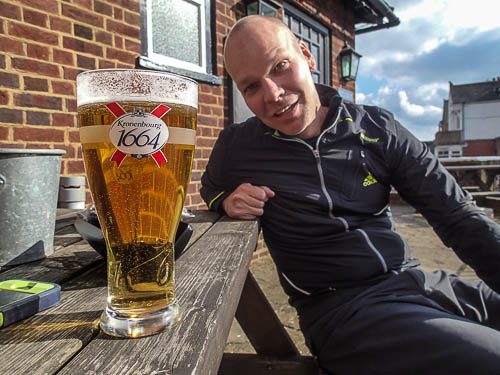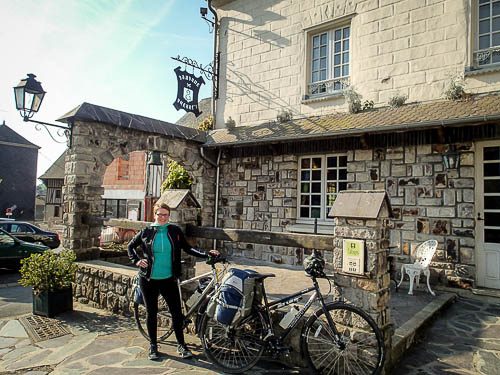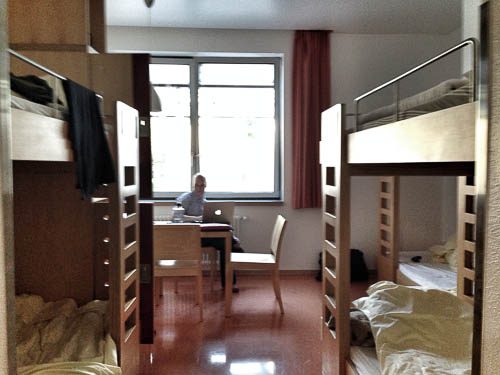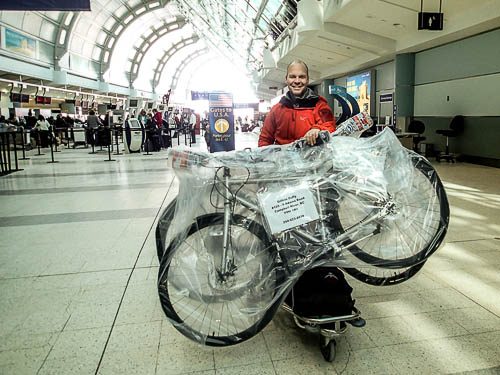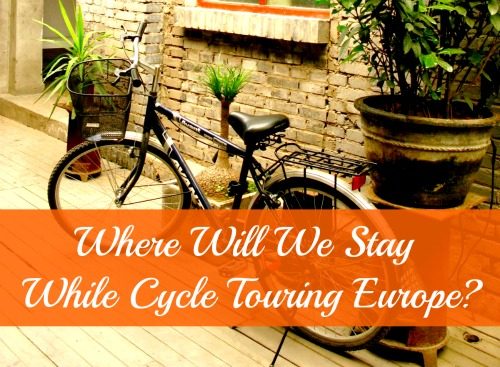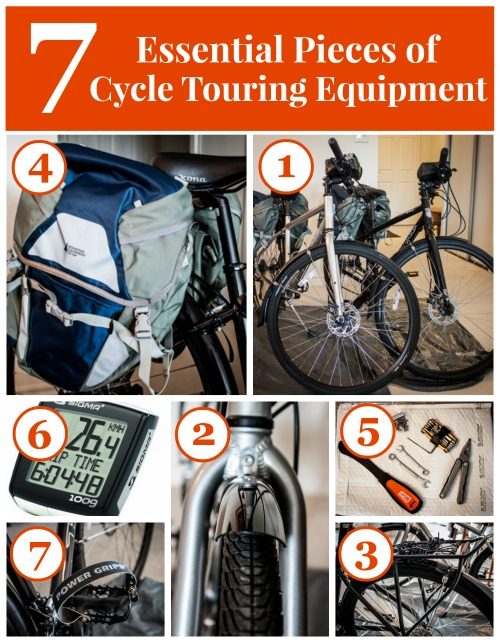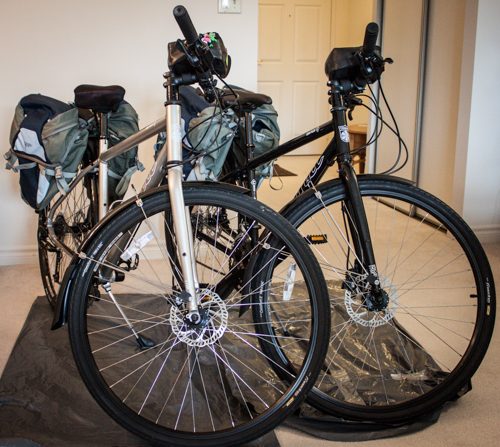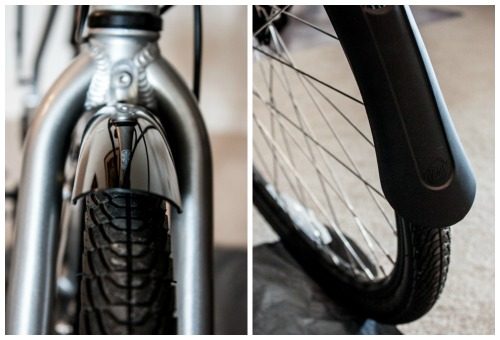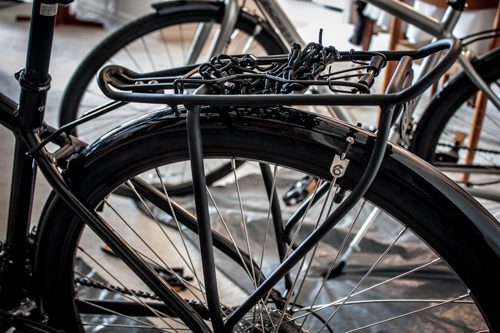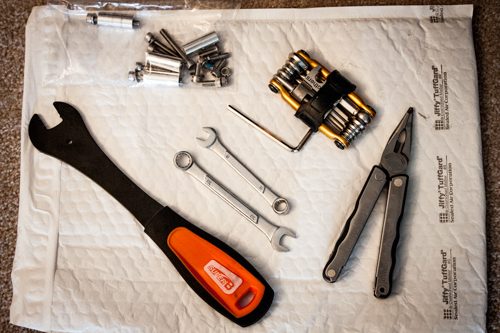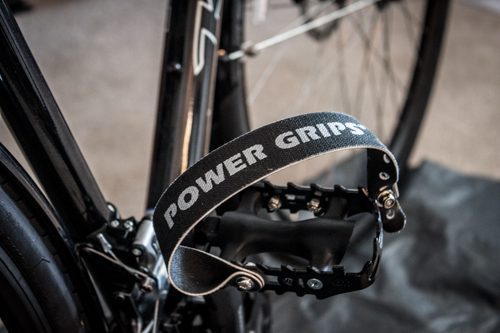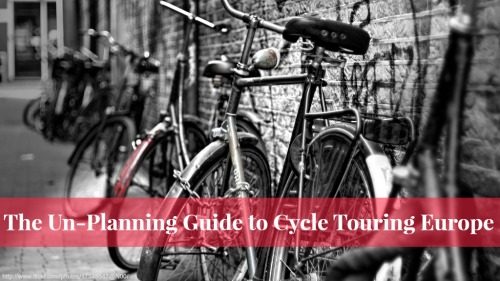Cycle Touring
Our triumphant, if soaking wet, arrival into Munich; 78 days and 2440 KM after we started in London.
It was bittersweet to reach the end. On the one hand it was a lot of work to be constantly on the move but, on the other hand, we really loved cycling through the countryside seeing parts of countries that we would never normally get to see. We would miss it whenever we stopped for a few days and always had such big grins on our faces at the end of each riding day.
Every day I would be amazed that I was in the middle of absolutely nowhere pedalling my way through a foreign country without a care in the world. Just the wind in my face, the feeling of the bike underneath me, and the whir of my tires on the pavement. I love, love, loved it. There isn’t a single day that I didn’t enjoy. Not even the very first day when I barely made it up the hill to our bed and breakfast, or the day with 3 flats, a broken rack, and a malfunctioning GPS unit, or the day(s) that it rained incessantly and we were soaked. They were all good. Really.
And that’s what I’m going to miss. The riding. The being outside on my bike every day. Wheeling through the tiniest of villages. Wrestling traffic in the big cities. Heading down unmarked tracks. Rolling through farmers fields (we seem to have ridden through an inordinate number of farmer fields). Stopping for a well earned beer. Cresting the hills. And screaming down the other side. Seeing the look on peoples faces when we tell them we rode our bikes here…from London. Knowing that I did ride my bike here…from London. Almost 2500 kilometres. I’ll miss the riding. Every. Single. Day.
*****
My body held up for the most part.
My butt hurt like hell for the first week. Not when actually in the saddle but when I would lift off the seat; the blood would rush back in, the numbing would cease all at once and all the feeling I was missing would return in one fell swoop. YOUCH!! That was the worst of it and it eased after that first week. Thankfully, I never suffered any chaffing thanks to the boy-short undies I wore (no inseams) and the…um…application of vaseline to delicate parts. Messy but way more comfortable. Yep, you can file that in the things-you-didn’t-want-to-know-but-might-find-useful-later bin. You’re welcome. 🙂
I had feared my lower back might ache from being hunched over the handle bars all day but it didn’t bother me even once. I guess all those core exercises I did over the winter proved useful after all. I have two rebuilt knees (the result of long ago mountain bike accidents), and I wondered how they would take the constant revolution and pressure but they did amazingly well and only required Advil on the longer days.
Interestingly it was my hands and feet which suffered the most. They became numb from the hours of pressure – we would have to stop every few hours to let the feeling return. Unfortunately it was cumulative and they got worse as the trip went on requiring breaks more and more often. We’ve been off the bikes for more than three weeks now and my hands still hurt when I put pressure on them. Bummer.
It really is amazing what you can ask your body to do and it will just do it. Day after day after day after day. In fact, we’re now in the position of undoing what the biking has done to our bodies. Our quadricep (thigh) and back muscles are very strong but our hamstring (back of the leg) and stomach muscles definitely took the summer off. We’re getting back to running and working out very slowly as we try to build up those parts without pulling something in the process.
*****
As the end drew near, and we were pedalling our last days, we started the ‘last official’ countdown; the last official big bridge crossing, the last official hotel to book, the last official flat tire, the last official picnic lunch, oh nope that’s the last official flat tire, the last official packing of the panniers, and finally, the last official day of riding.
And we officially realized that we weren’t done.
I loved it so much that I can’t imagine travelling through Europe in any other way. Hopping from city to city to city on trains just feels jarring and un-natural. Cycling allows an evolution from countryside to village to town to suburbs to city that just feels right.
Luckily, we don’t have to be done. Well, we have to be done for now (visa rules, and our wallets, say we’re done for now) but we’ve managed to store our bikes and gear in Munich (Jason’s sister just moved there and had room – thank you Tracy and Brian!!) and plan to return as soon as we can to continue on.
Who knows what that will look like, or where we’ll go (although there is talk of riding from Munich to Crete in Greece – how cool would that be?), but it feels good to have the option open and to know that, one day, I’ll be riding again with the wind in my face, feeling the bike underneath me, and listening to the whir of my tires on the pavement.
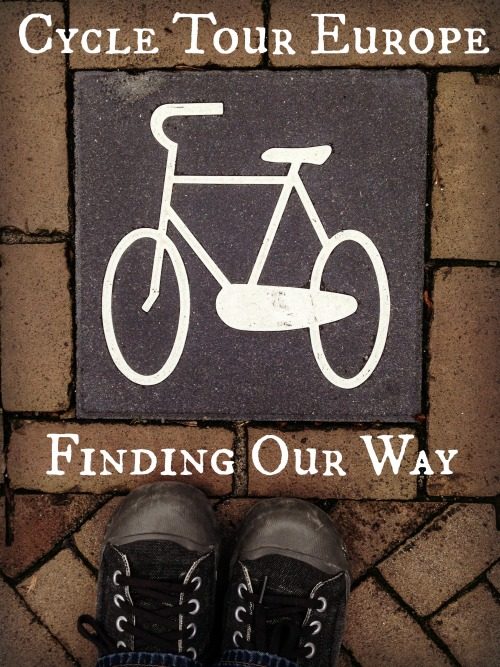 Of the three formidable tasks in cycle touring – determining where to go and how to get there, finding a place to stay, and deciding what and when to eat – the first and second combined to be the most work. (Primarily because, when you cycle that much, you will eat just about anything at just about any time!)
Of the three formidable tasks in cycle touring – determining where to go and how to get there, finding a place to stay, and deciding what and when to eat – the first and second combined to be the most work. (Primarily because, when you cycle that much, you will eat just about anything at just about any time!)
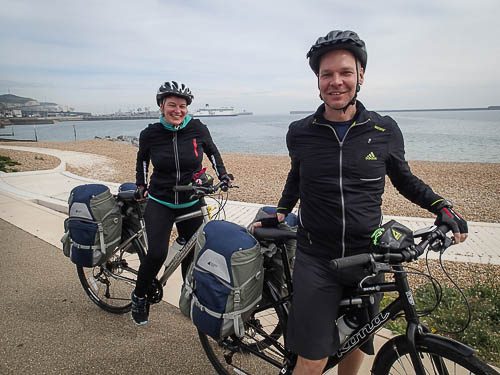 Europe has plenty of well-marked velo routes, but our itinerary (such as it was) never seemed to sync with many of them. We certainly found ourselves on many bike paths but we never simply followed one marked route for very long. Instead, it was a combination of deciding the long term destination – for example, the Vimy Ridge Memorial in northern France – and then finding a route to there over a number of days.
Europe has plenty of well-marked velo routes, but our itinerary (such as it was) never seemed to sync with many of them. We certainly found ourselves on many bike paths but we never simply followed one marked route for very long. Instead, it was a combination of deciding the long term destination – for example, the Vimy Ridge Memorial in northern France – and then finding a route to there over a number of days.
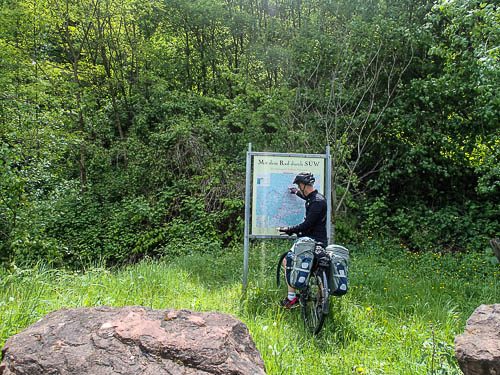 A quick series of questions usually determined this for us:
A quick series of questions usually determined this for us:
- What is the terrain like? This helps us decide how far we can go in a day. If it’s flat and smooth we can go a lot further than if it’s hilly.
- What towns are there along the way? The ‘no camping’ rule means that we can’t just stop whenever we are done for the day – we need to make it to civilization at some point. In some areas, such as northern France, the distance between towns is farther and so greatly impacts our ‘how far can we go’ decision.
- Which of those towns have reasonable places to stay? Once we’ve decided on a possible distance, and a town to stop in, then we look for a place to stay. It is certainly possible to not book ahead but we found that it caused us a great deal of stress to not know where we were staying for the night. The idea of rocking into town at the end of a long day of cycling and trying to find something that fit our budget and comfort levels just did not appeal – we needed a destination, a determined stopping point, where we knew we could shower and rest and it wouldn’t break the bank. I usually looked in the town we had agreed upon and, if I couldn’t find what I was looking for, then I would start looking at the smaller towns on either side until I found something.
What Tools Did We Use?
Traditionally, cycle tourists use paper maps for navigation. The problem with paper maps for longer term trips (besides the fact they’re made of paper and it rains) is the weight and room they take up. You’ll need maps in the 1:50,000 scale in order to really see where you are, and where you’re going – they don’t cover much ground so you’ll need a lot of them!
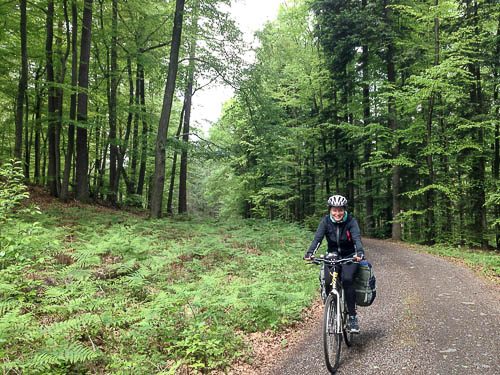 We wanted to take advantage of technology as much as possible and thought we could use our trusty iPhone and Google Maps to lead the way. Then we realized that we would be crossing borders essentially in the middle of nowhere – where were we going to get a local SIM card? There would be no vending machine at the border in the middle of a farmers field!
We wanted to take advantage of technology as much as possible and thought we could use our trusty iPhone and Google Maps to lead the way. Then we realized that we would be crossing borders essentially in the middle of nowhere – where were we going to get a local SIM card? There would be no vending machine at the border in the middle of a farmers field!
Our cycling friend in London offered up a great solution. He was using a GPS unit to find his way and recommended the Garmin Edge Touring Navigator to us. After learning more about it from him we quickly made our way to the local bike shop to get one for ourselves.
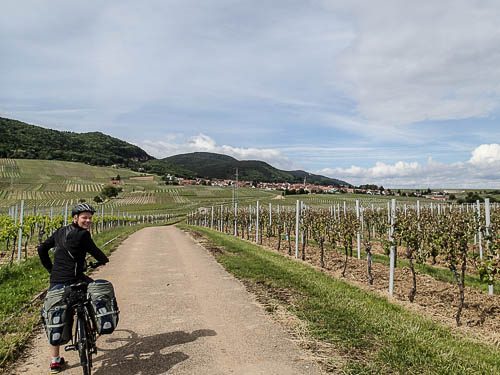 It worked brilliantly. Jason plotted our route on the Garmin website and then uploaded the route to the device. While riding we simply followed along. If we went off route for any reason he could see the underlying map to self-navigate or to get back on track. It also recorded our actual route; KM’s covered, time actually spent moving, time spent not moving, total time, and elevation changes.
It worked brilliantly. Jason plotted our route on the Garmin website and then uploaded the route to the device. While riding we simply followed along. If we went off route for any reason he could see the underlying map to self-navigate or to get back on track. It also recorded our actual route; KM’s covered, time actually spent moving, time spent not moving, total time, and elevation changes.
When we needed a larger overview, wanted to know exactly where we were, or were looking for a beer or lunch spot, we would pull out the phone and use Google Maps to help out. The combination worked really, really well.
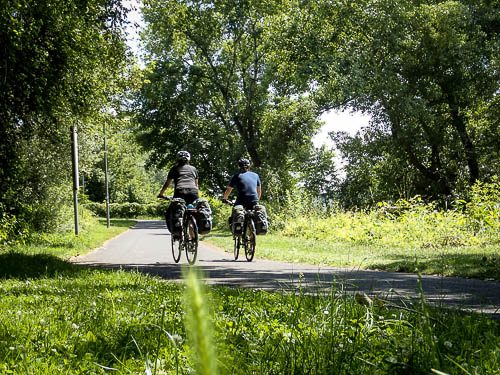 To support all this technology we carried an external battery. The HyperJuice Micro is the size of a mans wallet but carries enough power to recharge the phone three times over. We obviously charged everything up every night but there were some longer days where the power was getting low and it was a relief to know that we had a back up to rely on. We didn’t use it often but we were happy to have it when we did use it.
To support all this technology we carried an external battery. The HyperJuice Micro is the size of a mans wallet but carries enough power to recharge the phone three times over. We obviously charged everything up every night but there were some longer days where the power was getting low and it was a relief to know that we had a back up to rely on. We didn’t use it often but we were happy to have it when we did use it.
Finding Places To Stay
Accommodation isn’t traditionally part of navigation but, when where you can stay determines where you go, it becomes an important part.
Believe me, you can spend hours in the rabbit hole of finding the perfect place to stay. Checking out tons of booking sites, reading all the reviews, and determining the minute differences between Hotel A and Hotel B.
Or, you can write out a list of criteria that defines your perfect place and then stop looking once you’ve found it. Just stop. If you think there is something better out there then you must be missing something on your criteria list. If it meets all your criteria then it must be perfect. Stop. Looking.
Our criteria for this trip included:
- Budget – it’s always #1
- Proximity to our intended destination
- Walking distance to food and drink – we did not want to get on our bikes again after showering
- Breakfast included – so we could fuel up and get going in the morning
- Wifi available
- Decor/Style – will we feel comfortable there? Funny, this is becoming more important the more I travel (and the older I get). If we stay in a shit place I just get cranky and don’t want to spend any time there. A nice place = a happy Gillian. 🙂
- Bike storage – although I stopped worrying about this pretty early on. We’re in Europe, lots of people bicycle everywhere. Every place we went, except one, found a safe and secure place for us to store our bikes. One place, right near the Frankfurt train station, wanted us to leave our bikes in the main, public, parking garage around the corner. Yeah, right. We had to convince him to let us schlepp them down stairs to their utility room for the night.
We stayed in some really interesting places; hundred year old inns, rustic farmhouses, apartments perched overlooking valleys, and cute and cozy little bed and breakfasts.
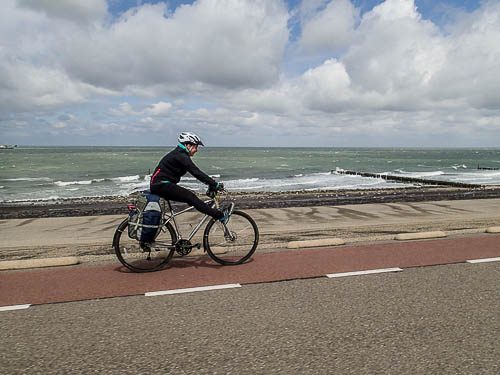
I started out this trip using a number of hotel/hostel/pension/B&B/guesthouse booking sites. In the end I used Booking.com almost exclusively. I like their website experience, the selection of properties, the on-site reviews, the payment process (pay on arrival, not before hand) and that, most often, I could cancel for free almost up until the day of arriving. It was rare that I couldn’t find anything on there and had to use another, usually more local, site to find a place. I also liked that, as a registered user, I was privy to specials and ‘Genius’ deals that often meant we could stay in a property that would normally be out of budget. Score! Note: I tell you this because it’s honestly what I found was best. I’m not paid to say this nor do I get a commission if you use them. I just like them. A lot.
For longer term stays I used AirBnB.com to find apartments. They seem to have the best selection, are well used so have lots of reviews, and their website is easy to use. What I HATE about them is the booking fee. For longer term stays the booking fee adds a few cents to each night but for shorter stays it sometimes pushed a place to the edge of our budget. Not cool. HomeAway.com is a good alternative with no booking fees, but their selection is not as good. Shameless Plug: I wrote all about finding the perfect apartment in my book How to Find the Perfect Vacation Rental. Check it out.
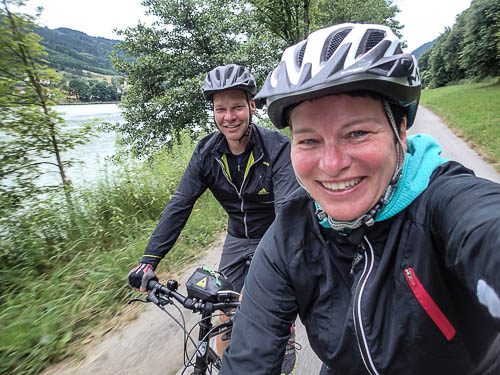 All-in-all it wasn’t that hard. Yes, it was a lot of work and took up a lot of time but it wasn’t that hard to figure it all out. It would be even easier if you decided to stick to one, or two, of the main velo routes. They are well marked, pass through some beautiful countryside, and have great cycling infrastructure alongside.
All-in-all it wasn’t that hard. Yes, it was a lot of work and took up a lot of time but it wasn’t that hard to figure it all out. It would be even easier if you decided to stick to one, or two, of the main velo routes. They are well marked, pass through some beautiful countryside, and have great cycling infrastructure alongside.
Disclosure: We were guests on the Theodor Körner however this in no way impacted the fabulous time that we had. I just thought you should know. 🙂
Our cycle tour Europe itinerary got a bit convoluted part way through. Itinerary is, in fact, a bit of a strong word for what we actually had. What we had was a basic circle route penciled out on a map that included most of the places that we wanted to see. Our real plan, though was to cycle as much (or as little) as we wanted to, enjoy Europe to its fullest (read: eat and drink everything possible!), and take advantage of every opportunity that came our way. Mission: Accomplished.
Our real plan took us through the beauty of Northern France, through historic Luxembourg, along the south end of the Rhine River in Germany to Freiburg to visit old friends. It saw us up and over the Swiss Alps (by train – we didn’t cycle over the Alps!) to feast on pizza and red wine on the banks of Lake Como before taking an epic 8 train (with seven train switches!) journey to Brussels in Belgium. After drinking as much beer as possible in Belgium, and falling head-over-heals for Amsterdam, we rode along the absolutely-unexpectedly-stunning coast of the Netherlands before entering Germany (again) to cycle the truly-appropriately-named ‘Romantic’ section of the Rhine. Another slightly-less-epic train journey took us to Passau in eastern Germany so we could finish our cycling adventures in style as we boarded the Theodor Körner and biked and cruised along the great Danube river. See, convoluted but a truly successful plan!
So, I wanted to tell you about the Rad & Reisen Cruise because I think it’s an absolutely perfect way for folk (like you) to enjoy cycle touring the best parts of Europe without having to enact a plan like above and cycle the 2500+ KM that we did.
Everyone can cycle tour Europe. Everyone. In fact, I’ve already recommended this exact cruise to my sister-in-law and my friend here in London because I think they would love, love, love it.
Here’s a link to the Passau-Vienna-Passau cruise that we took. I won’t detail the route as you can look on the site for that information (and see all the other options they offer all over Europe) but I will tell you what I liked, and what I didn’t like, about the cruise (because that’s what really matters!)
Generally the cruise works like this. The ship acts as a floating and moving hotel. You check into your cabin at the beginning of the week, leave all your non-cycling stuff there, and go cycling along the river each day. At some point during the day the ship passes you and magically appears at the end of your cycle just when you need it for a hot shower, a cold beer, and a great meal. Repeat. Repeat. Repeat. Repeat. Repeat. Cycle touring perfection. Easy, peasy.
Ship Facilities
Built in 1965, the Theodor Körner is one of the oldest passenger ships fording the waters of the Danube. Lucky for us though it was completely renovated just this past winter so the facilities on board were brand new and very comfortable.
Our twin, side-by-side, berth cabin was more than I expected from a river boat. The beds were comfy, the window opened, the closet easily held all our stuff, and the full bathroom had a real toilet and a powerful, and hot, shower. During the day one of the berths was tidied away to create more space and was magically made up for us each night while we enjoyed dinner. No, it’s not a massive room but keep in mind that you’re on a ship – it was more than comfortable and, really, you’re only sleeping in there – there is plenty to do on, and off, the ship to keep you out of there!
The Panorama Bar at the front of the ship is where all the action happened. Coffee and cake in the afternoon, before dinner beers, route information meetings, and evening entertainment all occurred in this quite stylish lounge. I enjoyed spending time here except when the entertainer was playing. I really did not like the entertainment. Perhaps it was a demographic thing. Maybe I need to better appreciate old ‘classics’ from the 60’s and 70’s. It may just be that I have a thing against Casio keyboards and electronic accompaniment. It doesn’t matter; it was like nails on a chalkboard and I just couldn’t handle it. Luckily, there were other options.
The Back Deck was where you could usually find us. Comfy lounge chairs, great views, shade from the sun (or, more likely, the rain), and blessed silence. Perfect. Although there wasn’t a bar on the Back Deck we could bring our beers back or ask for service if we didn’t feel like making the hike to the bar.
There were two other lounge areas available; neither of which we really used. The Library is a comfortable, quiet, indoor lounge and the entire roof of the ship is a sun deck also – alternately too hot or too wet to use during our journey.
The ship was really comfortable, and casual. You won’t need to bring your best sparkly dress and high heels, just some comfy clothes and a smile.
I’ll make a quick note about bar prices. I have been on other cruises which, not only did not allow outside drinks on board, but then fleeced me when I ordered a drink. Not cool. This didn’t happen on the Theodor Körner. In fact, we felt no need to bring drinks on board because they served cold, perfectly poured, beer where ever we were for the same price as on shore. Very cool.
Dining
Seating is assigned on board; you receive a table number and sit with the same people all week. We were seated at a table for six amongst a few tables of English speakers – thoughtful, as we have had a few meals on our trip with non-English speakers and it can be a bit…quiet. Our group of Australians, New Zealanders, Russians, and Canadians had a great time getting to know each other over our meals. Space was a little tight but we managed although I wouldn’t want to be at a table with a bunch of burly guys.
Breakfast was buffet style with a good variety of bread, meat, cheese, yogurt, fruit, and cereal along with some hot options such as eggs, bacon, sausage and mushrooms. We filled up at breakfast in order to fuel the riding for the day. Those who stayed on board during the day were offered a prepared lunch; those of us riding made up some quick sandwiches which were wrapped up for us with a piece of fruit and a chocolate bar for a picnic lunch later on.
Dinners were good and varied. A menu was placed in our cabin each evening so we could choose our evening meal the next day; usually a choice of meat, fish, or vegetarian. Each meal had an appetizer, a main entree, and dessert. Some meals were better executed than others; I would say that the fish dish was the most consistently good throughout the week. Wine was available at a cost but you could buy a bottle, have a glass or two out of it, and they would save it for you for the next day. Nice. My favourite part was after dinner. Along with the usual coffee service they came around with a bottle of schnapps or digestif to finish off your meal. A different bottle was offered each night; I sampled them all and proclaim them all to be delicious!
Bikes/Gear
Of course we had our own bikes and gear for the cruise, as did a number of others on board, but it was possible to arrive with nothing more than your bike shorts and a smile. You could rent all the gear that you needed; 7-speed, 21-speed, and electric bikes were all available at a very reasonable price. The bikes all appeared in great condition – and were well sized for each participant. Each had a small repair kit, a handlebar bag (which all riders received even if you had your own bike) and a side pannier to store the stuff you’d need for the day. Helmets aren’t mandatory here but you could buy one for a a couple of euros if you wanted to be safe. Each rider was assigned a bike but there were many, many, many more on board so, if you didn’t like the one assigned, another could easily be found. Everyone I spoke to seemed to be quite pleased with the equipment they had rented.
The crew took excellent care of the bikes, whether rented or our own. They stored them away on deck for us each night and had them all lined up and ready to go well before we were ready in the morning. My only complaint here was that it had rained on the bikes one night and my seat was wet in the morning. Petty, I know, but it wouldn’t have taken much effort to have given them all a quick wipe to save our wet bums.
Route Information
This is what made the experience for us. We’ve spent weeks and weeks and weeks and weeks cycling through Europe. Determining where to go, figuring out the best possible route, discovering interesting stops along the way, searching for places to stay, and always looking for regional cuisine and the best beer we could find. It’s takes a lot of time and effort and there is no doubt that we cycled right by some of the best that Europe has to offer simply because we had no idea it was right there!
On board, each cycling group had been issued a route book which not only included daily detailed maps but also turn-by-turn instructions to accompany the map. Every afternoon Andreas the cruise director held a meeting (once in English and then again in German) to review the next days cycle route. It wasn’t the detailed routing information that we were after though – we could easily get ourselves from Point A to Point B – no, the best part of the meeting were all the secret spots he pointed out along the way. Places that you wouldn’t know were there unless someone told you about them (or you could read the German signposts).
It was the charred mackerel (with ice cold beer) for ‘second breakfast’ one morning, knowing which castles were worth climbing up to (and which brewed their own beer!), refreshing glasses of Most (local apples cider) on hot afternoons, bicycle museums to explore, schnapps tastings on the cycle-only river ferries, platters of delicious food we enjoyed at the taverns he recommended along the way, whiskey and wine tastings, and the best coffee and ice cream must-stops.
Each days cycle had two possible routes – usually one on either side of the river – a recommended route and an alternate route. Andreas described each route (along with each ones hidden secrets) and explained why one would be recommended and one would be alternate so it was easy to choose which route we wanted to take. You can bet we always chose the one with the most tasty options along the way. 🙂
Biking Route
The riding was easy. Really easy. Downhill-trending-smooth-flat-with-a-tailwind easy. Anyone could ride it easy. You could totally ride it easy. There were some alternate routes and spurs that we did that were not flat and smooth but you don’t have to do those bits. The regular route is mostly on bike only paved or packed gravel paths and only on lightly trafficked roads occasionally – and those roads expect cyclists on them. It is very safe. There were a few families riding with children as young as seven or so and they were fine. Any hills or roads with cars on them were clearly pointed out by Andreas during the route information meetings so there are no surprises. You could totally do this.
It’s beautiful. I’ll let you in on a secret; we preferred riding the Danube to riding the Romantic Rhine. I know! I’m surprised too but the Danube was so peaceful, and green, and quaint. The villages were cuter and friendlier, the people didn’t seem tired of tourists or expect them to be there, there was no railway right along side with trains barrelling along every 10 minutes, and most of the time the only river traffic were the kayakers slowly drifting downstream. It was nice, and calm, and relaxing.
We rode between 35 and 50 KM’s each riding day. There were 5 riding days total and one day off in Vienna (if you didn’t book the biking tour, that is). There was no set starting time each day – we didn’t all leave en masse or ride together, although we all generally left between 8 and 9 AM and tended to ride in the same groups leapfrogging each other along the route all day. We had all day to get to the end point and were free to stop wherever and whenever we wished. We were often the last on board, having taken our time eating and drinking along the way, and we always had plenty of time to get ready for dinner. There is no need to rush the cycling – there is lots of time.
We luckily had no breakdowns or accidents (well, one of our group did have trouble staying on his bike but fortunately suffered no real injuries other than the hit to his pride) but the cruise director is always available by phone should the need have arisen. This isn’t a guided tour but it is well supported.
Excursions
There were a few excursions available throughout the trip. A bus or bike tour was offered in Vienna – we did the bike tour and really enjoyed it. An evening operetta was also offered in Vienna but opera sounds, to me, like cats screeching and makes my ears bleed so we went to a nearby wine house instead. I think we made the right choice. In the small village of Grein a young resident came and gave us a tour of the historic theatre in town – it was a fun glimpse at what used to make a small town click and a revealing look at how villages like this are struggling now as young people move away and tourism replaces industry in the economy.
Who Else Was On Board?
I wasn’t at all surprised by who our fellow passengers were. Mostly Germans, with a smattering of Belgians and our little international English speaking section. There were a couple of families with children on board but the average age was mid-60’s I would say. It’s an active cruise so people are fit and mobile of course. Although we never had any deep conversations, most people spoke some English and all were very friendly. They certainly were all interested in having a good time – we were often tucked away in bed well before they had danced their last dance in the Panorama Bar in the evening.
Value
So, is it worth it? I can’t decide that for you. We usually travel on a tight budget and Budget Girl (that’s me!) is loathe to spend extra on things that we can do ourselves for a lesser cost (and really, it doesn’t matter how much less, Budget Girl is a hard-ass!). Having said that, I am SUPER HAPPY that we took the cruise. We really enjoyed it, thought the facilities and service were excellent, and got SO MUCH out of having someone do most of the planning work for us.
If you’re wanting to do some cycle touring yourself but aren’t sure if you want to do all the work involved then this is definitely a great option. Like I said, I have already recommended it to my friends and family as I think they would really enjoy it.
You can check out all the Rad & Reisen Tours on their website; they have a bunch, there’s bound to be one where you’re going!
It would seem that, after cycling through the hills of northern France, we should have been grateful for the flat lands of the Rhine Valley.
I am here to tell you though that not all flat is created equal. As with everything in life there is always a hierarchy and flat has one too.
Although I’m not one to usually look a gift horse in the mouth, flat is not all that it’s cracked up to be.
Yes, it’s easier on the legs than an uphill but it doesn’t offer the resting opportunities of the downhill that usually accompanies the up. Every inch of road gained must be worked for – there is not coasting, no lifting your tired, achy butt up off the seat, and no ‘woooo-hoooing’ down the other side. Every revolution counts, there is no free ride.
After many hours of traversing many kilometers of flat (and not-so-flat) terrain I have developed the following Flat Dictionary:
Downhill Trending Flat: This is the Queen Bee of flat. Click into the highest gear and speed along the landscape feeling like Superwoman with legs of steel and a grin that can’t be beat. It’s almost better than downhill…(1) because I didn’t have to climb a hill to get it and (2) because I often don’t realize it’s downhill trending and I feel so strong whereas I know when we’re really going downhill and just let gravity do it’s thing.
Flat Flat: True flat. Riding is easy but getting into the highest gears takes effort. We’re grateful for it after an uphill section but, after a while, grow weary and miss the variety of up and down. You really can’t please some people, can you?
Uphill Trending Flat: Definitely one of the worst. I often cannot see that it is uphill trending; my legs feel like they are filled with concrete, the bike feels like it has a dead body on the back, and I’m constantly downshifting in order to keep moving at a slug pace. Unlike true uphill where there is a summit to focus on and sense of success to be gained no matter how steep the hill, this flat is soul sucking, misery-inducing, and confidence-shattering. We even did one section of Uphill Trending Flat that actually appeared to be Downhill Trending – farmer fields on either side belied the truth and had me preparing for a Superwoman section…only to be doubly confused as my pace slowed and my legs screamed. I had to look behind me to be sure that Jason hadn’t grabbed on trying to pull me backwards. Tricky Uphill Trending Flat…tricky!
Smooth Flat: Smooth flat is where it’s at. The smoother the better.
Tailwind Flat: Nothing better than a helping hand from Mother Nature. A tailwind can make a riding day pass easily as we sail along whistling Dixie (well, not really) and enjoying the ride.
Headwind Flat: A headwind, however, can suck the fun out of a day faster than well I-don’t-know-what, but fast! It actually doesn’t take much of a headwind to make a difference but if there’s a storm brewing it can make riding downright nasty. Like pedalling in sand, or uphill in sand, or uphill in sand with a flat tire. Not only is the riding harder but it pretty much also heralds the oncoming rain – yay, now I’m tired and wet. Not my favourite.
 Rough Pavement Flat: You know, pavement that maybe didn’t have the right mix of wet to dry ingredients. The pebbles stick out and the surface is anything but smooth. Friction counts and riding on Rough Pavement Flat is more difficult than trying to determine the coefficient of friction in physics class.
Rough Pavement Flat: You know, pavement that maybe didn’t have the right mix of wet to dry ingredients. The pebbles stick out and the surface is anything but smooth. Friction counts and riding on Rough Pavement Flat is more difficult than trying to determine the coefficient of friction in physics class.
Gravel Flat: A tiny bit worse than Rough Pavement Flat, Gravel Flat now has small rocks to negotiate. This isn’t so difficult but is wearing as the bike is a little bit less stable so it takes a little more energy to manage that dead body on the back of my bike.
Grassy Flat: There is, of course, a whole hierarchy of Grassy Flat alone. Short grass vs long grass. Tufted grass vs carpet type grass. Fortunately we don’t do much Grassy Flat riding and it’s usually accompanied by beautiful country-side views so we’re happy.
Broken Pavement Flat: Another one of the worst. Broken pavement has no pattern, no defined way to tackle it, nothing to redeem it at all. It slows us down immediately. Time riding on Broken Pavement Flat is spent zigzagging across the road trying the find the smoothest route through the minefield of pot-holes and uneven surfaces.
Farmer Field Flat: Farmer Field Flat is an amalgam of many flats. Never really flat, it’s often uphill trending (are we always going the wrong way?) and sometimes will downhill trend. Often grassy (of the tufted variety) but sometimes there is a track of mud, hard-packed earth, or cobblestone. Usually accompanied with amazing country-side views but also with the earthy smell of cows. It is peaceful and relaxing.
Cobblestone Flat: Sounds quaint, but it ain’t. Cobblestones are tough to ride on and will slow us down faster than just about anything else as we try to find a path through that is smoothest and offers the least resistance. I love the way they look and appreciate the hardiness of the style but it is tough on the butt!!
Rocky Flat: Rocky Flat’s rocks are larger than gravel rocks. There are usually more of them but not as many as on a rocky beach. The effect is the same though – the tires must ‘swim’ through the rocks as they don’t actually ride over them but sink just a little. It’s tough to navigate and stay upright and, thankfully, we have so far only seen very short sections.
So, as you can see, the absolute best flat you could find would be downhill trending, smoooooth, and with a tailwind. That would be heaven!!
—–
Stay in touch by checking out the OneGiantStep Facebook Page! I may not post here as often as I’d like but I’m managing to post pictures and updates there more often.
Holy cow!! We’ve been on the road for more than two weeks already. Never mind Let’s Get Started…let’s get caught up!!
We set off from NorthWood in northwest London on a somewhat dull day. We were undeterred by the weather though; excited to finally be on our bikes and on our way.
Our plan was to take the train into the centre of London and start pedalling from the iconic Tower Bridge. The first leg however (and indeed the whole first day) did not go according to plan. The trains were running late, very late, and we became unsure if we would be able to take the train into town at all which would mean tacking on another couple of hours to our already uncertain 60KM of planned riding for the first day. Luckily our persistence paid off and we managed to ride the train close to our hoped-for starting point.
There’s so much caught up in that first day. Our brave smiles on the bridge don’t show the nervousness we felt in not knowing what the hell we were doing. Would we be able to cycle as far as we thought? Would we be able to find our way? Would we like it? What the heck had we gotten ourselves into?
Excitement carried us through the small lane-ways and river paths that led us along the Thames to Greenwich where we stopped for lunch. Not knowing what was ahead of us helped push us forward toward Chatham where we had a bed booked for the night.
And then came The Hill. It started out innocently enough; a gentle grade challenging us to take it on, mocking us with its green boulevards and civilized sidewalks. It was, in fact, pure evil. Six kilometres of uphill, never steep enough to warrant getting off the bike and yet pure torture for my poor legs which had already pushed for fifty-some-odd kilometres on the very first day.
I stopped. A lot. And at the top I lay down and willed the blood to return to my legs while at the same time dreading it as it would also mean I would feel them again and it was bound to be pure agony.
We, of course, stopped for a beer for we were still not at the very top and still had a ways to go.
I’m not ashamed to tell you I walked the final kilometre to our guest house. I could no longer ride, my legs were jelly, and tears stung my eyes. We were hours later than expected, sweaty, tired, and spent.
Our hosts (bless them!) took one look at us and rushed to put the kettle on for a much needed cup of tea. We tried our best to make conversation as we gulped back the tea and inhaled the sugar cookies that became our dinner as we had absolutely no energy to find anything else. After a quick, soothing, hot shower we sank into bed without even enough taking time to consider how we were going to manage the coming days.
We reviewed our plans over one of the best breakfasts I’ve ever had the next morning.
Re-evaluating our abilities (or lack thereof) we decided to scrap our scheduled routing for the next few days and instead took the advice of our host, Pauline. We quickly booked train tickets to Canterbury and spent the day wandering around the old town and cathedral, resting our riding legs and gaining back some confidence.
The following day we followed a much less trafficked route on our way to Dover. More fields, more cows, less kilometres, and a better riding day. We arrived at the beach feeling back on track and ready to tackle ‘the continent’.
Crossing over to northern France things became much quieter. We cycled through small villages and historic towns, through many fields, and often didn’t see cars for miles and miles and miles.
The countryside was beautiful and peaceful. Our legs were adjusting to the riding and no longer protested every revolution and, while it wasn’t flat, the hills were manageable and usually were followed by much welcomed downhill.
We snacked by the side of the road soaking up what little sunshine was offered. The weather has been cool but not too wet – we have, so far, avoided getting drenched but surely it’s only a matter of time!
The first tire flat came on Day 11 and was quickly followed by four (!) more on Day 14. Needless to say we have become quite proficient at changing tires. All the flats were in the original tubes in exactly the same place (on a seam) of the ‘Made In Thailand’ pieces of rubbish. We’ve now managed to replace them all and hope they are a little more hardy. Enough is enough already!
Accommodations have varied and have often determined our route and/or the length of a day. There are not a lot of towns or larger centres in northern France so we look at the map, figure out the elevation change in the direction we want to go, determine how far we can ride within the topography and try to find a destination within that range. Then we have to find a place to stay.
Some places are so small that there is only one option so that’s where we end up – luckily they often also serve dinner and breakfast. It is these places that are the most interesting. Usually historic buildings (some more than one hundred years old!!) and often family-run; we muddle through with a smattering of high-school French, enjoy their generous hospitality, and are on our way again in the morning.
(I have to say that France is a bazillion times more welcoming than I was expecting. We had originally planned on spending minimal time here after hearing stories of snobbery and misfortune but have found people to be super kind and extremely patient with us. Many people speak a teeny bit of English and will slow down to help us understand them. They are proud of their establishments and are happy to have us visit. I’m glad we’ve spent more time here and have thoroughly enjoyed it.)
As we crossed into Luxembourg the other day we realized the downside of entering into larger cities…more expensive accommodations…and so we tried out our first dorm room in a hostel. It turned out to be a beautiful, modern, hostel with small 6-bed dorm where we met a nice couple and enjoyed chatting and sharing stories for the evening.
Our trip is evolving into exactly the experience we were hoping for; we’re seeing great swaths of countryside, meeting more people than we ever have before, and are enjoying being well off the beaten track. I’m amazed at what we can ask our bodies to do each day. We take things as they come and don’t get caught up in what we ‘should’ be seeing or doing – it all just presents itself and we take it all in stride.
KM Ridden: 598
# of Riding Days: 13
# of Rest Days: 6
Flats so far: 5
Injuries so far: 1, although not riding related. Jason walked into a door and cut his head. Bummer.
—–
Stay in touch by checking out the OneGiantStep Facebook Page! I may not post here as often as I’d like but I’m managing to post pictures and updates there more often.
One of my goals for this trip is to do some more video, which won’t be hard because I’ve hardly done any at all!
What’s hard is actually doing it. I can’t tell you how long it took me to put this first, pathetic, creation together. I thank you if you manage to get through it. 🙂
All I can say is it has to get better from here. If you have any tips, tutorials, or lessons you can point me toward I would really appreciate it (and so will you once I get better!).
Anywhoo…we landed in London this week and unpacked the bikes…
After spending the winter getting all our cycle gear together we had to figure out a way to get the bikes to our starting point in London, England.
There are basically two methods of shipping a bike; breaking it down and boxing it up, or sliding it into a bag. After researching both methods, and weighing the pros and the cons of each, we decided to go with the bagging method. Not only does it require less taking apart of the bike but there is a theory that if baggage handlers can see that it’s a bike then they will be more careful with it – plus they can’t be stacked like when they are in a box.
You can use any heavy duty plastic bag – it’s finding one that’s big enough that is the tough part. We found these at Wiggle.com and had them sent to us. They are quite a thick polyurethane and stand up well to baggage handling.
Packing them up turned out to be pretty easy.
 Protect the derailleur. This isn’t a necessary step but we know from experience that derailleur hangers are easily bent and a bent derailleur can quickly derail a good day. 🙂 It’s held on with just one bolt so comes off really easily. We then just wrapped it in bubble wrap and taped it to the frame for safe keeping.
Protect the derailleur. This isn’t a necessary step but we know from experience that derailleur hangers are easily bent and a bent derailleur can quickly derail a good day. 🙂 It’s held on with just one bolt so comes off really easily. We then just wrapped it in bubble wrap and taped it to the frame for safe keeping.
 Turn the handlebars. Simply loosen the headset and turn the handlebars for a narrower profile. We also turned them under to protect them just a little more.
Turn the handlebars. Simply loosen the headset and turn the handlebars for a narrower profile. We also turned them under to protect them just a little more.
 Reduce the tire pressure. This is an airline requirement. They don’t have to be flat – just take out enough air to allow for expansion in different air pressure environments.
Reduce the tire pressure. This is an airline requirement. They don’t have to be flat – just take out enough air to allow for expansion in different air pressure environments.
 Secure the front wheel. We taped the front tire to the frame just to stop it from wiggling about too much and make it a little easier to handle.
Secure the front wheel. We taped the front tire to the frame just to stop it from wiggling about too much and make it a little easier to handle.
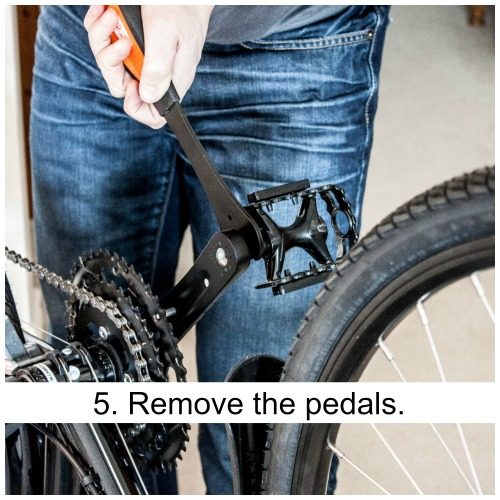 Remove the pedals. Use a pedal wrench to remove the pedals so they don’t stick out through the plastic bag.
Remove the pedals. Use a pedal wrench to remove the pedals so they don’t stick out through the plastic bag.
 Bag it up. The bag is just that – a massive plastic bag open at one end. Simply push the bike into the bag, fold over the end, and tape it all up. We used a LOT of tape – we didn’t want any flappy bits and wanted it to be as secure as possible. Once it was all wrapped we realized that one handle bar end looked a little exposed so we cut down a juice bottle and taped it to the end. For the second bike we placed the juice bottle protection inside the plastic wrap. Don’t forget to add some identification! We printed up labels with our name, destination address, and phone number so that they would be reunited with us if they got lost along the way. (Use a transparent report keeper to protect the paper label.)
Bag it up. The bag is just that – a massive plastic bag open at one end. Simply push the bike into the bag, fold over the end, and tape it all up. We used a LOT of tape – we didn’t want any flappy bits and wanted it to be as secure as possible. Once it was all wrapped we realized that one handle bar end looked a little exposed so we cut down a juice bottle and taped it to the end. For the second bike we placed the juice bottle protection inside the plastic wrap. Don’t forget to add some identification! We printed up labels with our name, destination address, and phone number so that they would be reunited with us if they got lost along the way. (Use a transparent report keeper to protect the paper label.)
The bikes have taken one flight since being packed up and they survived quite well. All we need to do for our upcoming flight to London (tomorrow!!) is check on the taping and switch out the address label to our London destination.
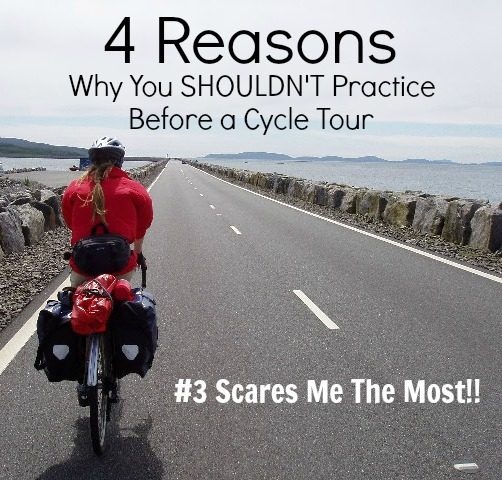 I have read a TON of cycle touring blogs in the last few months. I have read gear lists, and packing lists, and itineraries, and food plans, and camping tales (enough of these to make me secretly glad that Jason doesn’t camp – it doesn’t sound like a ton of fun!), as well as a lot of practice schedules.
I have read a TON of cycle touring blogs in the last few months. I have read gear lists, and packing lists, and itineraries, and food plans, and camping tales (enough of these to make me secretly glad that Jason doesn’t camp – it doesn’t sound like a ton of fun!), as well as a lot of practice schedules.
Practice schedules. All the advice says, and most people do, head out on their bikes at least once before hitting the road for their cycle tour. A chance to shake out the cobwebs, make sure all the equipment is working right, and to gain the strength in their legs (and their lungs) to power them through the ride.
We haven’t done any of that.
I know, it sounds crazy…but we have some very good reasons:
1. Why get a sore bum early?
There is no doubt that your a$$ is going to hurt like a son-of-a-b*tch once you start riding for hours on end. I can’t imagine that there is anything to be done now that will make that not happen – unless, of course, you replace your office chair with a bicycle seat until you leave. So why subject yourself to such torture before you absolutely have to?
I’m not. There is only one way to work through the bicycle seat pain and that’s to just keep on going so I’ve resigned myself to the fact it’s going to hurt for a while and I’ll deal with it then. Starting now only increases the pain period and, really, who needs that?
2. It’s winter.
We have spent the last nine months in southern Ontario here in Canada through what is reported to be the worst winter in 20 years. Temperatures averaged -10C (14F) and dipped as low as -25C (-13F); I haven’t seen so much snow since I was a little girl. Great weather for building snow forts, ice skating on the local pond, or snowmobiling through the fields but not so great for trying out the new bikes.
There are a couple of ways you could practice even through an icy winter like this one:
- Join spin classes. Almost every gym these days offer spin classes; a great way to get cardio training in while strengthening those all-important let muscles.
- Get an indoor trainer. This is a great option because you can hook your own bike up to it and train on the actual bike that you’ll be riding all those kilometers later on.
We, of course, did neither of these things. We have been working out like crazy and doing loads of stair sets but, although we’re in good shape, I know that running up and down stairs is not the same thing as riding a bike. So, I say, what’s the point? Is that time on the trainer, or those spin classes, really going to make a difference once you get on the bike?
3. What if you don’t like it?
This is probably my biggest fear. What if I start practicing here and discover that I don’t like it? What if I think it’s too hard or it hurts too much? Getting on a bike and practice riding around familiar neighbourhoods and up the dreaded hills you know are coming is quite different than jumping into it in a foreign country where everything is new and exciting. If I know that I have to push through to the end of the day, I just will because I have to. I don’t want to jump on a bike here and start to doubt whether I can do it or not – I’ll just dive in head first and assume that I’m going to love it!
4. Can you really be prepared to ride a bike for up to 8 hours a day?
Is there any amount of on-the-bike training or practicing that would really prepare me for riding 6, 7, or 8 hours a day day-after-day? I think not. Unless I was prepared to ride for 6, 7, or 8 hours a day day-after-day leading up to our actual cycle tour of Europe. Reason #2 takes care of that possibility, and thank goodness because although I’m really looking forward to riding through Europe, stopping at cafés and pubs along the way, the appeal (for me) of riding that much in Canada, past cow fields and through long stretches of desolate highway, just isn’t the same.
I don’t think we’re as unprepared as it must sound. We rode mountain bikes for years and years when we lived on the west coast of Canada; we are very familiar with being on bikes in all kinds of terrain and weather. We’ve ridden for hours on end and done multi-day trips so we know the level of physical activity we’re getting into. We work out regularly and so are in fairly good shape – both cardio and strength – and we are well aware that being ‘in shape’ doesn’t mean it won’t hurt and that we won’t find muscles we had no idea we had!
I guess only time will tell. I’ll let you know if our ‘no practice’ routine was a good idea or not!
You’ll notice that there was no camping gear in the equipment list that I published last week. You see, Jason doesn’t camp. Well apart from that time that I convinced him to hike the Tetons with me a couple of years ago and, of course, the Inca Trail to Machu Picchu but, generally, the thought of pitching a tent and climbing into a sleeping bag has him saying no to my great ideas well before I can even get them out.
So we needed a compromise for cycle touring Europe this summer. We can’t afford to stay in hotels the whole way, and besides, our plan has us cycling through a whole lot of countryside where traditional hotels and hostels might not be available.
There are a couple of options that are available:
WarmShowers.org is the CouchSurfing of the cycling set. People who are willing to host cyclists sign up and provide their contact information while cyclists looking for accommodation options sign up and fill out a profile. Hosts are flagged on a map and cyclists simply look at the map to find a host that may be nearby and then send them a message.
Hosts are typically cyclists themselves and are interested in meeting like-minded folk who enjoy both travel and cycling. Accommodation is free; it is the exchange of conversation and goodwill that fuels the exchange.
Loosely translated (very loosely as I don’t know any Dutch!) this is Friends of the Bike. It works very similarly to WarmShowers but with more of a bed and breakfast feel to it. In fact, that is exactly how it works. Owners register their property with the organization and are required to provide a few basic cycling necessities; there needs to be a private room, space to store the bikes, and a breakfast upon departure. Cyclists ‘donate’ to the organization and receive a registration card, a map with all the hosts mapped out, and a booklet listing all the possible places to stay; they simply connect up, show up, and enjoy a relaxing evening. There is a cost for this option though; 19 Euro per person, per night.
Our plan is to intersperse some longer urban stays in amongst the long days of cycling. A chance to relax and get to know a city as well as get some work done. You know how much we love renting apartments and this is a perfect occasion; we’ll be able to relax with coffee and breakfast in the morning while catching up on work and then spend the afternoons and evenings exploring and enjoying our new neighbourhood.
It will be an interesting mix of places to stay. I’m a little nervous about staying with other people but, at the same time, it’s one of the things I’m looking forward to. It’s out of my comfort zone but I have long lamented that I don’t think we ‘get under the skin’ enough when we travel; this is an experiment in doing that. I guess I should really be worrying that I will be as good a guest as I’m hoping the hosts will be 😉
While we’re obviously not cycle touring experts….yet…even we know that there is just some cycle touring equipment that you can’t tour without.
There is a whole lot of geekdom surrounding bike gear and you can spend hours searching through the should’s and shouldn’ts of bike gear. We’ve taken a much more relaxed approach; I think that you don’t have to spend big money in order to get equipment that will do the job. Of course we’ll have to see how this all works out – I’ll report back once we get on the road and let you know how it’s all holding up.
Cecilia is on the left. Bartholomew on the right.
1. Bike. This is, by far, the most expensive piece of cycle touring equipment and it’s easy to go crazy, and spend a lot of money, trying to find the perfect bike. I’m not saying that the expensive ‘touring bikes’ that are available aren’t worth it. I bet they are extremely durable and offer a smooth ride for many, many miles but we just don’t have the money to invest in high end bikes.
I have ridden Kona bikes exclusively for many, many years. I started mountain biking in 1998 and my very first bike was a Kona Cinder Cone. As my skills increased, and bike technology evolved, I replaced it with a Kona Stinky in 2002. I loved that bike; I named him Frank and we spent many good years together. I sold Frank in 2007 and picked up Gus; a beautiful green Kona Coil Air. With this bike I could do anything I wanted to do – we rode up countless hills together and ripped down them even faster. It was with a heavy heart that I put him up for sale in 2012 but it was the biggest sign of commitment to our new plan that I could muster. It was worth losing him but I can’t tell you how much I miss spending my Sunday mornings riding with the guys.
And so when looking for affordable cycle touring bikes the first place I looked was Kona. Kona has some great bikes specifically made for cycle touring but they were far out of our price range. They do, however, have a good commuter/hybrid option that looked like it would be perfect; durable enough to get through the tour, not too heavy even when fully loaded, and at under $700 we could manage the cost. The Kona Dew Plus should serve us well.
Meet Cecilia (my bike) and Bartholomew (Jason’s). Yep, we have matching bikes. It seemed silly to find two different bikes when we found the one that would work. And yes, I always name my bikes; the name just comes to me. This is the first girl bike I’ve had.
2. Fenders. I’ve never had fenders on a bike before. Getting muddy was always part of the fun in mountain biking. But, when riding for hours on end trying to make up miles, we are not going to want road spray mucking us up. I’m sure there are some high end, super duper, fenders out there but we went with this basic version from Mountain Equipment Coop (MEC; our Canadian version of REI). These from Amazon.com look just the same.
3. Racks. As we won’t be camping during this trip we really only need rear panniers so we only needed a rear rack to hold those panniers. We happened to order ours from Wiggle.com – they had the bicycle packing bags we were looking for and we needed to bolster our order so got our racks there too – again, these from Amazon.com look very similar. It’s worth noting that if your bike has disc brakes that you ensure that the rack can accommodate mounting around them.
4. Panniers. Ortlieb panniers are the gold standard in cycle touring. They are tough, durable, waterproof, and expensive. We did not get Ortlieb panniers. In fact, for the price of one set of Ortlieb panniers we picked up two sets of MEC panniers (on sale). At 56L per set we will have more than enough room for all the gear we plan on carrying plus they have plenty of pockets and straps to allow for organization which I like. They are not, however, waterproof. We have waterproof bags for our electronics and plan on finding a plastic liner to help keep the rest of our stuff dry-ish.
5. Tools. We’re lucky. Although we’ll be cycling self-supported we are also cycling in one of the most bike friendly areas on earth. You can’t go far in Europe without hitting a town, and a bike shop. This means we don’t have to carry all the tools and parts necessary to completely rebuild a bike (like, say, if you were biking in Asia or South America). We do, however, need to be able to do basic repairs, tire changes, and do emergency McGiver repairs if need be.
We’ll have a basic tool kit with us:
- A chain maintenance kit with chain lube, a brush, and rag.
- A cycle specific multi-tool with various screw driver heads, allen keys, and a chain break.
- A basic leatherman tool with pliers, knife, and screwdriver heads.
- A regular multi-tool with scissors, small knife, and tweezers.
- A couple of bike specific sized wrenches.
- A folding knife.
- A patch kit with patches and glue along with tire levers to get the tire off the rim.
- A pedal wrench for removing the pedals if we decide to ship the bikes ahead at any time.
- And a corkscrew; although I don’t think that’s bike specific 😉
6. Bike Computer. Probably not essential but how else are we going to know how far we went, how long it took, and how fast we were? We got just a very basic version but you can go all out and get elevation and GPS trackers too if you like.
7. Power Grips. What, you ask? Well, most long-haul cyclists ride ‘clipped in’. This means there are special clips on the bottom of their shoes that attach their feet to the pedals. Being ‘clipped in’ to the bike is a much more powerful way to ride as you can pull up with your rising pedal as you push down on the downward pedal. It’s like having little wings on your feet to help you get up the hills. However, this means that the shoes you cycle in can only be used to cycle in; the metal clip on the bottom makes using them useless as walking or hiking shoes and so you must carry ‘regular’ shoes also. This is added packing and also added expense – not only for the special shoes but also for the special pedals.
The other, much older, option are toe cages; metal cages that attach to the pedal and into which you can slip the toe of your shoe into. A little clunkier, and not as powerful as being clipped in, but better than nothing.
But then I stumbled on these Power Grips. They’re like the best of both worlds. They work with regular shoes like toe cages do but they strap your foot in much more strongly and so offer much better power than toe cages. I’ve never actually used them before but by all accounts they should really work. I’ll let you know how it goes. Note: we ordered the Power Grips kit and were surprised when it came complete with pedals. We should have ordered just the straps and attached them to our own pedals; that would have saved money.
**********
Read all the other posts in our pre-trip Cycle Tour Europe series:
The Un-planning Guide to Cycle Touring Europe
My last post about trip planning for our upcoming cycle tour of Europe was all about the work we had to do in order to be ready to hit the road again. You might think that we have been feverishly poring over cycling resources, mapping out our route, and planning how the heck we’re going to get ourselves around Europe on our bikes.
Well, not exactly. This is turning out to be the most un-planned trip we have ever taken. And I am strangely ok with it.
We have done some work. Our bikes and equipment are sorted out and we have all the clothing gear we’ll need – more on this next week – but as far as exactly where we’ll go and exactly how we’ll get there, we just haven’t figured it out yet.
I think it comes down to how we want this trip to feel. It was when we went to Japan that we started to plan our trips based on what we wanted it to feel like, rather than listing off a bunch of must-see places. It’s too easy to get caught up in wanting to see everything and then we end up rushing around, frustrated because we’re always on the go and not enjoying what it is we are experiencing. Identifying what we want the trip to feel like helps us plan an itinerary and determine the schedule.
For this trip I want to feel FREE.
I want to not have a plan at all. I want to just take each day as it comes and not know what the end of the day will look like. I want to be spontaneous and just figure it out as we go. I want to be able to just say YES to whatever comes our way.
It’s not that we don’t have a plan. We do; it’s just really, really rough. I think we’ve put together an itinerary partly to answer the inevitable question of ‘where are you going to go?’ and partly to ensure that we don’t just park ourselves in a London pub and never move. Not that there would be anything wrong with that.
So, here it is, like I said, roughly. It’s a circular route threading through ten countries; England, France, Belgium, Luxembourg, S.Germany, Czech Republic, Poland, N.Germany, Sweden, Denmark, the Netherlands, and back to England.
Some 4700 km. I know. It’s a long way. I made a map.
I’m not sure we’ll make it the whole way in the 3 months that the Schengen Zone rules allow. My heart won’t be broken if we don’t though because it will mean that we found something more interesting along the way, that we decided to slow down, or go somewhere else, or maybe we’re still in that London pub.


